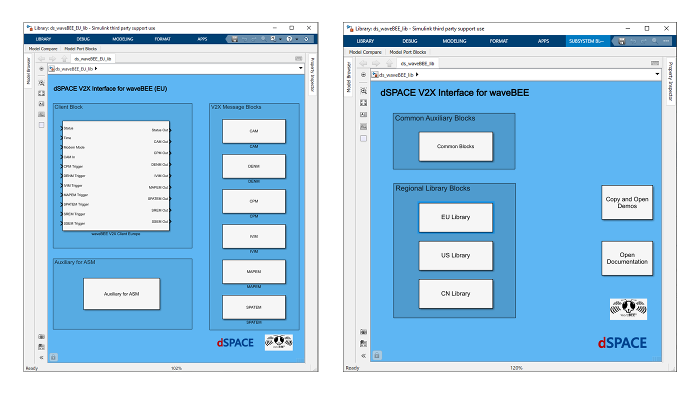Integration of advanced dSPACE HIL- or PC-based simulation solutions for ADAS/AD into a waveBEE V2X simulation environment.
What is the dSPACE V2X Interface for waveBEE?
The dSPACE V2X Interface for waveBEE allows for easy integration of V2X communication into the advanced dSPACE HIL- or PC-based simulation solutions for ADAS/AD utilizing Keysights waveBEE solutions for V2X.
Application Areas
Vehicle-to-everything (V2X) communication – which allows cars, infrastructure like traffic lights or cameras at intersections, and vulnerable road users to communicate with each other and see around corners by sharing sensor information – will be a key enabler for more comfortable, more efficient, and safer driving. V2X will lift cars to a higher level of cooperation and autonomy. However, the greater complexity of V2X-enabled use cases, such as sensor sharing, platooning, or cooperative driving, and close integration with vehicle functions for perception, sensor fusion, and maneuver planning make using V2X beyond Day One more challenging with regard to testing and validation, thus requiring more advanced SIL and HIL simulation. The V2X Interface for waveBEE, which integrates the waveBEE V2X simulation environment by Keysight with SCALEXIO or VEOS, and dSPACE Automotive Simulation Models (ASM), together with the included infrastructure, can help you tackle the complexity of testing to bring your connected vehicle to the market faster, regardless of the V2X technology or world region for which your product is intended.
Key Benefits
The V2X Interface for waveBEE lets you address a wide range of use cases, from V2X Day One applications to collective perception and cooperative driving. Support for functional testing and seamless integration into the PC-based SIL platform VEOS with a smooth transition to integration tests and HIL system tests makes it possible to reuse simulation models and test scenarios during the main stages of the development process. Realistic HIL simulation with SCALEXIO and waveBEE, including channel attenuation and load generation, ensures stable testing and validates the reliability of your device and applications. This is complemented by ASMs with comprehensive models, including sensor and infrastructure simulation, to generate complex messages such as MAP or SPAT, allowing you to focus on the actual test and validation task. Finally, the seamless integration with dSPACE test solutions for ADAS/AD, e.g., physics-based sensor simulation, and the use of cutting-edge test methods such as scenario generation and scenario-based testing help manage complexity and reduce the workload and expenses when testing functions for connected automated vehicles. Since the solution is based on standardized V2X protocols, you can even integrate and use your preferred simulation models and test environments.
Functionality Overview
Functionality Overview
| Functionality | Description |
| General |
|











